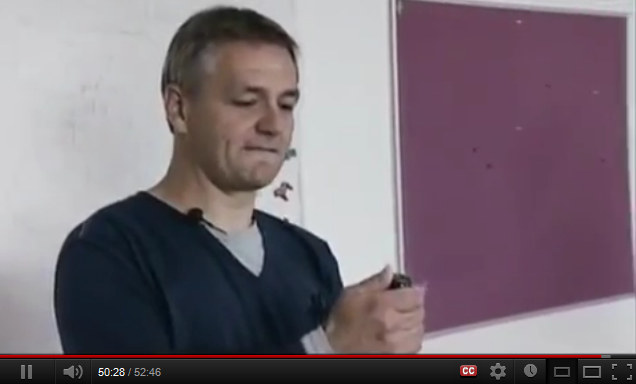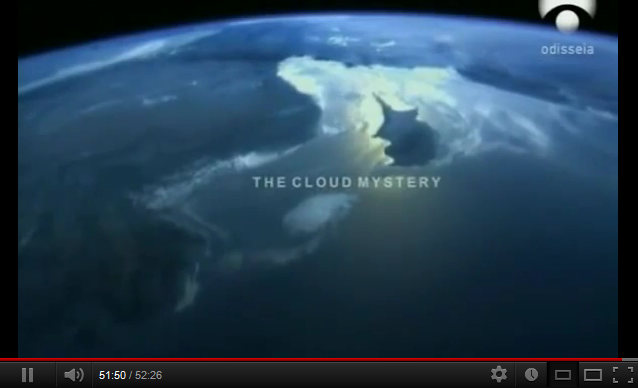CLIMATE CHANGE WITHOUT PEOPLE! Climate fluctuations come from the sun's intensity, which sometimes varies. + Ice ages come when the solar system is passing an arm of the Milky Way. Link: Climate change by galactic year - CO2 is NOT the cause for climate changes: http://www.hist-chron.com/welt/klimawandel-durch-galaktisches-jahr-ENGL.html But politicians do not know that the ice ages were also WITHOUT people !!! - Michael Palomino, May 9, 2019
When solar system is passing an arm of Milky Way there will be a glacial period - and more proofs
The curves (lines) with the correlation between solar activity and temperatures on Earth from 1860 to 1985
Curves with the correlation between sun spot number (solar activity) and cosmic radiation.
Nir Shaviv describing cold (C) and hot (H) periods of the galactic year: passing an arm of the Milky Way=C=Ice Age
Film protocol by Michael Palomino (2014 / 2018 / 2019)
from the movie "The Cloud Mystery" with Henrik Svensmark: http://www.youtube.com/watch?v=ANMTPF1blpQ&feature=related
| Teilen / share: |
Facebook |
|
Twitter
|
April 2012: Climate change by galactic year - CO2 is NOT the cause for big climate change
Summary
This scientific investigation (by Henrik Svensmark from Denmark) shows clearly the important result that the cloud forming depends from the sun's activity. And it's also proved that the big climate changes with the Ice Ages are depending from the position of the Earth in the Milky Way which has 4 spiral arms. So when the Earth is passing one of the spiral arms then will be an Ice Age. One complete turn around the center of the Milky Way (with 4 passages of the 4 spiral arms) is called "calactic year" and is lasting 250 million years. Here is the film protocol with the investigation which was performed by the group of Mr. Svensmark (with 35 photos):
Solar activity is reducing cosmic radiation from the outside - and there will be less clouds with higher solar activity
Cosmic radiation has the effect forming aerosol particles forming clouds. Sun has different phases of activity, one time more (with more sun spots) and another time less (with less sun spots). More solar activity provokes more sun radiation in solar system and less cosmic radiation can enter from Milky Way into our solar system. Less cosmic radiation provokes less cloud formation and provokes a hotter climate on Earth.
Galactic year of our solar system: passing spiral arms of Milky Way causing glacial periods
Milky Way has the form of a spiral, and our solar system is amidst in it on it's own orbit: this orbit is called the galactic year (which has 250 millions of years for one orbit around the milky way's center). On this orbit our solar system is passing some spiral arms of Milky Way galaxy, and in these arms cosmic radiation is especially high provoking much cloud formation and therefore provoking glacial periods.
Sea's temperatures also are in correlation with cosmic radiation
Geochemical investigations can measure the content of oxygen in fossils and therefore it's possible to determinate the water temperature of the sea of the last 500 million years. There is a direct correlation between cosmic radiation and sea's temperatures.
The Film links
The English film "The Cloud Mystery" is here: http://www.youtube.com/watch?v=ANMTPF1blpQ&feature=related
The film "The Cloud Mystery" in English has no indications of the persons which is very sad. Fortunately the German version has got the indications, so the photos were taken from the German version.
More data about the film "The Cloud Mystery": It was written and directed by Lars Oxfeldt Mortensen. Editor Niels Ostenfeld. Photogarphy: Nikolai Ostergaard, Yosi Leon, Karl Roeder, Bo Tengberg, Lars Oxfeldt Mortensen, Lars Skree. Sound design Peter Schou. Original Music: Simon Ravn. Color grading: Morten T. Egholm, edithouse. Additional editing: Isabel Brammer. 3D artist: Ole Samsoe Andersen. Script consultant: Nigel Calder. Special thanks: Anders Oestergaard, Michael Klint, Jens Olaf Pepke Pedersen, Jacob Svensmark. Archives: Artbeats, ESA / Hubble; NASA, material data AB; Elliot film; Getty images; Footage X-tra. Financial support: Tips OG Lotto Midlerne, Knud Hoejgaards fond, The Danish Ministry of Science; Produced by Mortensen Film in association with: Arte France, Unité de programme de couverte et connaissance, Hélène Coldefy, Chargée de programmes, Christine Reisen; Financed in association with TV2 / Danmark A/S. Commissioning editor: Kim Christiansen. Copyright Mortensen Film 2007
Content
The German version of the film is split into 5 parts which are presented here
- Part 1: Film "Secret of the Clouds" part 1: http://www.youtube.com/watch?v=BTtDgPrMwo8
(content: there is a correlation between the activity of the Sun, cosmic radiation, density of clouds and temperatures on Earth).
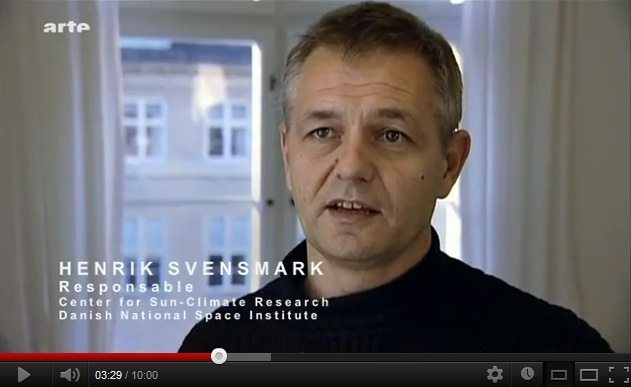
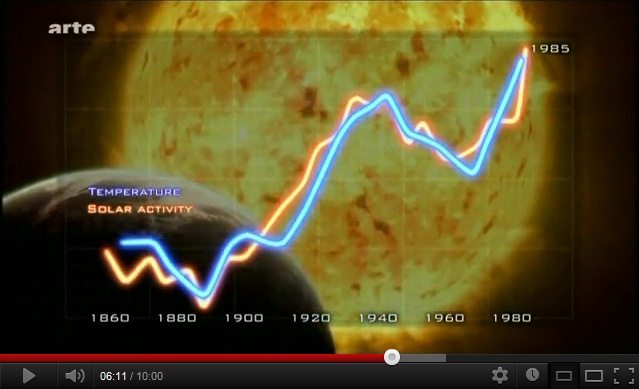
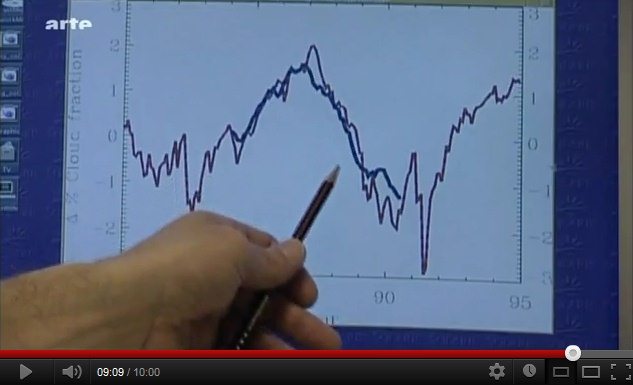
- Part 2: Film "Secret of the Clouds" part 2: http://www.youtube.com/watch?v=Ktu9Piuexp8
(content: excursion to Dead Sea, visit of the layering with interpretation of Sun's activity, formation of cliffs).
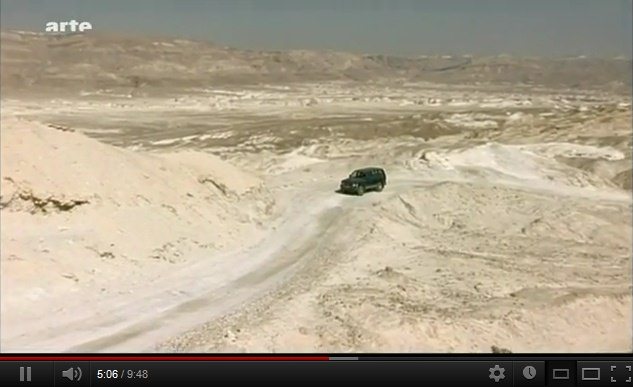
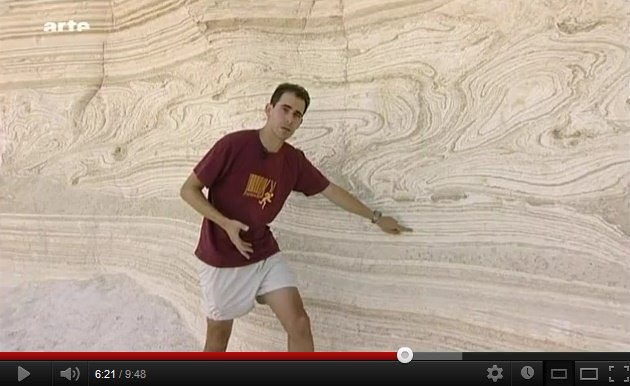
- Part 3: Film "Secret of the Clouds" part 3: http://www.youtube.com/watch?v=iEBF6iVSa6k
(content: lectures about formation of clouds by cosmic radiation provoking the formation of aerosol particles forming the clouds).
- Part 4: Film "Secret of the Clouds" part 4: http://www.youtube.com/watch?v=gLgqtyI-6hI
(content: Galactic year of our solar system passing spiral arms of Milky Way provoking glacial periods and between the spiral arms with warm periods).
- Part 5: Film "Secret of the Clouds" part 5: http://www.youtube.com/watch?v=-Qy-mVvHfF0
(content: there is also a correlation between temperatures of the Sea and the calculation of cosmic radiation - the experiment forming clouds artificially by cosmic radiation in Copenhagen).
The English film "The Cloud Mystery" is here: http://www.youtube.com/watch?v=ANMTPF1blpQ&feature=related
Film protocol
(Film 1 of the German version):
<Klimamysteriet (The Cloud Mystery)
Henrik Svensmark on climate change
Mortensen Film presents.
Speaker: <As telescopes extended outlook far beyond the system, we begin to realize that our world is unavoidably part of a stormy and creative galaxy. A new perspective is emerging. The galaxy drives our climate system, the ways we are only beginning to understand.
For more than a decade the Danish physicist Henrik Svensmark has worked on a new theory about the climate. This will alter our understanding of climate change.>
Henrik Svensmark, profile
Henrik Svensmark:
<The processes that take place in our universe from exploding stars and also dramatic changes in solar activity are affecting us much more directly than we ever dreamed of.>
Speaker:
<Over the years we have followed Svensmark in his struggle to be heard in a climate community with distant the idea that present day climate change might have natural causes.>
Henrik Svensmark:
<The fact is that clouds and water have the biggest greenhouse effect on the Earth's climate.>
Speaker:
<The secret is sought to be found in the everyday clouds in our sky.>
Henrik Svensmark:
<In times, when everybody is talking about CO2, clouds are a really important factor of climate change.>
Title of the film: THE CLOUD MYSTERY
Henrik Svensmark:
<Without clouds the climate on Earth would be completely different. And just small changes on the US cloud cover would change the US climate. So, understanding clouds is a very very crucial point. The mere idea that processes in space and not just processes on Earth are important for climate, I think this is deeply fascinating.
Henrik Svensmark, portrait, responsible of Sun and Climate Research Center of Danish National Space Institute
In 2005 we actually found experimental evidence the sun and the galaxy is determining climate here on Earth. But for some reason not one scientific journal wanted to publish this. It was a big disappointment for me and my team.>
Eugene Parker, professor of astro physics of Chicago University:
Eugene Parker, professor of astro physics of University of Chicago
<There is a problem that has always been with us. New ideas are rarely welcome in science where particularly some young person - not known in the field - proposes some radical new idea ime [?] experience great difficultly and getting it published.>
The connection between solar activity and temperatures on Earth
Henrik Svensmark:
<The bottom line seems to be that instead of thinking of clouds as something being - em - Everybody saw of the climate but it is actually a sort of upside down: It is that the climate is a result of the changes in the clouds. The first time I got an idea of how important clouds could be on the Earth climate, was when my bus [collection of data] Eigil Friis Christensen made a discovery where they found a beautiful correlation or agreement between solar activity and the Earth temperatures. The agreement was so good that is could not be accidental. And this was really a big inspiration for trying to understand and trying to use clouds as a part of that explanation.
Eigil Friis-Christensen, director of Danish National Space Institute:
Eigil Friis-Christensen, director of Danish National Space Institute:
<When we published this in 1991 it was at a time when everybody believed that the warming that had taken place during century was mainly due to cover dogs site increase, man made greenhouse gases. So, when this community saw this perfect, really perfect correlation between solar magnetic activity changes, the temperature everybody surprised.>
Eugene Parker, professor for astro physics:
<What we could see, was that when the magnetic activity of the sun was larger, then the temperature on the Earth was higher.>
The curves (lines) with the correlation between solar activity and temperatures on Earth from 1860 to 1985
Eigil Friis-Christensen, director:
<Nobody had an answer to what kind of mechanism could be the cause of that.>
Henrik Svensmark:
<We knew that somehow the magnetic activity of the sun had to have an influence on the Earth climate, direct or indirect. But how this would come about was a real scientific mystery. But one day, someone stepped into my office and mentioned cosmic rays. When I heard this word "cosmic rays" it made me immediately think of an experiment I did in high school where we had what is called a cloud chamber. Inside the cloud chamber you have super saturated air and when a particle for instance a cosmic ray goes through it makes a string of small droplets like a small cloud.
Cloud chamber with chains of dropsWith this image in my head I thought:
What if cosmic rays are responsible for forming clouds.
And what if the Sun with it's magnetic field is capable of changing the clouds on Earth. Then we would have a perfect explanation on how the Sun would be responsible for climate through our everyday clouds we see in the sky.
Formation of cosmic radiation
You cannot see the field of cosmic rays but they let loose whenever stars die in super nova explosions. As atomic particles with enormous energy they rush through the galaxy at almost the speed of light - and some of them [arrive] the Earth. But the Sun fights the cosmic rays and controls just how many hit the air. In order to find out if cosmic rays effect the clouds, I began to look for data. I collected satellite data about the variation of clouds in the atmosphere and compared them with variations in the cosmic ray intensity.
There was a beautiful clear cut correlation that surprised me more than I ever dreamed of.
Graphics with the curves showing the correlation between cosmic radiation and temperatures on Earth
The red curve shows the cosmic rays, you see the variation, and the blue curve that's for the cloud cover. It means that cosmic rays are affecting the Earth climate. And that's a fascinating thought. Since that means that space is very and directly relevant for us.
(Film 2 of German version)
Less cosmic radiation - less formation of clouds - warmer climate
The magnetic field that comes out of the Sun has more than doubled over the last 100 years. As a result fewer cosmic rays have sprayed the atmosphere and fewer clouds have formed. The consequence has been a warmer Earth. When a strong magnetic field comes out of the Sun fewer cosmic rays spray the Earth. fewer clouds to keep us cool. For a lazy Sun with a weak magnetic field lets in more cosmic rays from the stars. And in the air they make more clouds. That's how the stars and the sun control the Earth's cloudiness.>
Eugene Parker, professor for astro physics:
<The suggestion was made by Svensmark in Denmark that this effect of cosmic rays is really important. And he based that on the remarkable correlation between world wide cloud cover and the cosmic ray intensity. The magnitude of the effect - if his speculations are correct - would suggest that this is as powerful effect as the present green house effect or the brightness variations of the Sun. It remains to be seen now of course as the weather that effect is valid. It is a major contributor to this whole process that needs to be investigated very carefully.>
Paal Brekkem, former scientific staff member of SOHO satellite project of ESA:
<This idea with the cosmic ray modellation and the cloud cover is probably the most interesting mechanism today. If that...>
<What is found in that research results from Denmark is that there is a very good correlation with the clouds and the cosmic ray modellation which we have measured for 50 years or so.>
<But this shows that the Sun's magnetic field, how the Sun appears. That's very important to understand - and then we can go back to understand how the Sun has changed.>
Paal Brekkem:
<We know about the Sun's magnetic field had increased and we know the Sun is more and more active. The activity has been increased in the last hundred years by factor of two. If Svensmark's work is confirmed that he is right with this idea, I think it would have big effect on the whole climate discussion, because the clouds are so effective in changing the climate or trapping or closing out radiation.
It's now to do the research of this mechanism. And so I think we should do this seriously and try to understand this mechanism.>
The presentation of the correlation in Birmingham 1996
Scenery of a flight check-in.
Henrik Svensmark:
<When we presented our results in Birmingham in 1996, we were of course very excited to present the results, but much to our surprise it what we received [the reaction were] very very negative. And the only thing we had done was to present a scientific result which showed that the Sun through the clouds might be very very important for climate.>
Eigil Friis-Christensen, director:
<Eh, there was of course a reaction also from the International Penal on Climate Change, the UN Penal. Brad Walhim was the chairman, scientific chair that time. He was responsible of us to see that something else than the CO2 could be the main driver for climate.>
Henrik Svensmark in his presentation:
<So that is worked out that the Sun has an effect on climate.>
<The whole climate community really hated the idea that the Sun should have a major impact on climate. That was seen as a disaster. I was actually shocked about the responses that we got.>
Breaking ice shield, cars in floods, wind in the desert, factory with chimneys.
<During the last 25 years CO2 has been a dominating theory trying to explain all climate variation. However, if we look at historical climate there is absolutely no doubt that the Sun has been extremely important - and you cannot ignore it.
Stay in Dead Sea valley with a trip to Nahal Peratsim with a four-wheel drive car
Trip to Dead Sea valley to Nahal Peratsim
Nir Shaviv, astro physicist of Hebrew University of Jerusalem is telling us:
<We see here the Dead Sea and we are going to a place called Nahal Peratsim which is one of the nicest places where you can see the climate variations taking place here.
Stay in the Dead Sea: analysis of sediment layers - dark layers from winter, bright layers from summer
People have this conception that the Sun is this constant ball of gas and does not do anything. This is wrong. In reality the Sun can sometimes be very active. It's this solar activity, this dynamic nature of the solar activity which affects the solar winds and effects the cosmic rays and which eventually affects the climate here on Earth. Climate variations over the passed decades, centuries, millenia can be very - we reconstructed in many different places around the world.
Now we are located directly in the Dead Sea. Twenty thousand years ago the Dead Sea was higher. It was much and the level was than we are standing.
Nir Shaviv in Dead Sea valley showing the water level of 20,000 years ago
And every year there were deposits that were left on the floor. And here we see those annual deposits. Basically during winter dark deposits are left, and during summer the bright deposits are left. So the ratio between the dark and the white [layers] tells us a climatic story, tells us how the climate here varied the years.
Nir Shaviv showing the formation of layers in the Dead Sea valley, dark layers from winter, bright layers from summer times.
On these times of centuries and millenia you can reconstruct what the Sun was doing using the cosmogenic isotopes like carbon 14.
What is interesting is that this carbon 14 is directly formed by the cosmic rays. So this and other results and other measurements from around the world tell us that the Sun is affecting the climate. >
Return from empty Dead Sea valley with the four-wheel drive car.
"Little glacial period" 300 years ago - because of less solar activity
<This link between solar activity and climate on Earth it's not hypothetical. You just see this in the records: When the Sun was more active you indeed see that it was warmer on Earth and vice versa. 300 years ago for example the Sun was not very active and we were in the hight of the little ice age when it was cold in many places on Earth. A 1,000 years ago it was - eh - the Sun was active, it was as active as it is today and it was warmer everywhere. The Vikings could map all of Greenland because the Northern shores of Greenland were not frozen.
Most of the people today think that most of the climate change is because of CO2. But this is wrong. Most of the warming of the 20th century is because of the Sun.>
More cosmic radiation is reaching Earth by less solar activity - more clouds - less cosmic radiation is reaching by more solar activity - less clouds
Henrik Svensmark:
<If we look at Earth from space, we will see that about 60 to 70 percent is covered by clouds. If more cosmic rays come down we will have slightly more clouds - and you can imagine the opposite: Fewer cosmic rays, we have a little fewer clouds. Instead of thinking of clouds as a result of climate it's actually for sure that the climate is a result of the clouds. Because the clouds take their orders from the stars.>
(Film 3 of German version)
Calculations showing that cosmic radiation has got an influence above all with the lower clouds
<After we found the link between cosmic rays and clouds, we only knew that it was a sort of cloud cover. But I had to find out what type of clouds. And at some point it became possible with a new data set to investigate exactly this. And at that time I got help from Neichel Marsh.>
Neichel Marsh, portrait<He helped analyzing this data. And much to our surprise we found that the link is actually to the low clouds. So, it seems as if cosmic rays are changing low clouds. And that is very very good news for the whole idea.>
Stay in a big town:
<When I got this result, I saw the correlation was much better then I - eh - ever - eh - dreamed of.>
Paal Brekke:
<If you decrease the amount of low clouds, it will be more heating down to the ground. But in particularly now this work shows that the sun under the low clouds that changes which makes it very interesting. There is still of mechanism to explain this that is missing. And it's now important to do the research to try to understand this mechanism.>
Svensmark in a speech:
<There is a very large faction of low clouds. A large part are responsible for a large part of the cooling caused by these clouds.>
Svensmark:
<The reason the low clouds are so important is that they actually reflect a lot of the sunlight back into space. I mean we know them from travels in the air planes we see over the oceans, and they are white because they are reflecting - eh - the sunlight back into space. And you can imagine if you change the amount of low clouds you change the amount of energy that the surfers get. That means that low clouds have a strong cooling effect on the Earth climate. So, if we have more low clouds, climate will become colder. And we have fewer cosmic rays, we have fewer low clouds, and the Earth becomes warmer.>
White clouds reflecting sunlight
Group conversation after a speech:
Richard Turco, director of Tucla Institute of Environment:
<When I first heard about Henrik Svensmark's work when we became interested and looking at how aerosols or very small particles are produced in the air set atmosphere in the first place. And this is important because all clouds are formed upon aerosol particles that are in the atmosphere. The sunlight is looking at the Pacific ... The terms of the work there weaved on or we found is that the collective cosmic ray is capable of modulating the aerosols of particles and small particles in the lowest part of the atmosphere. In fact we can show that the aerosols produced by collective cosmic rays are significantly modulated in the lower layer which contains these clouds that produces the cooling effect on the Earth. What we don't understand at this point is exactly how and why they - their form.
Every cloud droplet is formed on a particle initially - in the air. way. And so it's absolutely crucial to understand how these particles come about and what their properties are. Otherwise we can ever hope to understand clouds and their behavior.>
Forming of clouds by cosmic rays: cosmic rays provoke the formation of aerosol particles
Henrik Svensmark:
Henrik Svensmark giving a lecture
Henrik Svensmark:
<And that's where cosmic rays exit might come in because what the cosmic rays do when they enter into the atmosphere: They produce small islands. It is the belief that this small charges help forming this small space of aerosols in the US atmosphere.
Richard Turco, director of Tucla Institute of Environment:
<Most people just think that there is just water in the atmosphere that naturally would be clouds. But that isn't true. The only way that clouds can form in the atmosphere in our atmosphere under normal conditions is the convince on to existing particle in the air. Every cloud droplet it's form this form on a particle initially in the air. All clouds are formed upon these aerosols. And so it's absolutely crucial to understand how these particles come about. And what their properties are. Otherwise we can ever hope to understand clouds and their behavior.>
Henrik Svensmark:
<In science it's not enough just to have a good theory. You also need some experiments to support the ideas. I was ready to make an experiment that could show that we had this connection between cosmic rays, aerosol formation and clouds.>
Higher solar activity with strong magnetic field hinders entering of cosmic parts into our solar system
Henrik Svensmark at a speech:
Henrik Svensmark at a speech (ev. in London)
Henrik Svensmark's speech:
<What I am going to talk about is cosmic rays. These are particles of very energetic particles. They are inter the Earth's atmosphere and [one] can actually measure them. So, when we have maximum activity you see that there is not so many cosmic rays coming to the Earth's atmosphere. That's because now the Sun has a very strong magnetic field and it's difficult for the particles that come from the galactic space to get into the solar system. So, that seems to be an agreement between changes in solar activity and changes in climate. So, what is really needed is some experimental evidence that can say yes or no, whether such a relation I mean how does it really work. That is what is needed. And it's very fortunate that such an experiment seem - look like that it will be performed.>
Curves with the correlation between sun spot number (solar activity) and cosmic radiation.
And there was some resistance against the well presented link between cosmic parts and cloud formation and climate change
Sir John Mason, former general director of weather board of United Kingdom was protesting he would never give any news about the connection between cosmic radiation, solar activity and cloud formation with climate change:
John Mason, portrait of a cosmic ray denier
<This experiment is coming .. that this experiment is completely misconceived regarding to elementary knowledge. So what is ever why you look it. That experiment is completely misconceived. I would tell nothing about it.>
Henrik Svensmark answering:
<Well I told you I disagree. But I should say that the people that is involved there, are people that they are experts in the aerosols and atmospheric chemistry. So, they know what they are doing, so. And I know, I mean, they will disagree with your point of view but it's true that there are different views, but you are one extreme I would say.>
Henrik Svensmark in the interview:
<I am many times giving talks were people have got very excited and very strongly trying to tell me what that I'm doing was completely waste of time.>
Visitor to Svensmark:
<Did you read my book?>
Henrik Svensmark:
<Oh, I know of your book.>
Visitor:
<Then you should not argue about the clouds. No, the whole thing a complete misconception.>
Svensmark in the interview:
<Not a single one has come out with anything from a scientific point of view that made me think that there was not something of real scientific question, where's presuming.>
Visitor to Svensmark:
<So I mean, what is the sense of the experiment?>
Henrik Svensmark:
<Well, there are written several papers where they discuss where the condensation parts actually comes from and how they form.>
Visitor to Svensmark:
<Oh we know that.>
Svensmark:
<No, it's not known, according to these persons.>
Visitor:
<O, just read the literature then.>
Svensmark describing the experiment in Copenhagen
<I had this theory. So, I decided that we should do an experiment in Copenhagen that could show whether my idea was right or wrong. Unfortunately it turned out to be much more difficult than I thought it would be. We actually started this without having no funds at all. And I just continued hoping I would get money at some point. Building the laboratory, building the experiment, getting the funds, it actually took almost four years. The idea in this experiment is to investigate what is the role of cosmic rays. And the idea is that we in the end we will be able to mimic the processes that are going on in the real atmosphere. So, this whole chamber is built in such a way that we can control ions inside it and - eh - we will be able to reveal for the first time how important ions are in the production of forming new aerosols and in the end new clouds. The motivation for doing this experiment has been really been trying to understand why it seems to be this relation between solar activity and climate on Earth. All this political turmoil what is surrounding global warming and so on is irrelevant for the science, and the kind of experiment that we are doing I think it's a necessary experiment because it will improve our understanding of one of the most important processes in the atmosphere which is cloud formation.>
(German version: Film 4)
The orbit of our solar system passing spiral arms of Milky Way
Nir Shaviv, astro physician at Hebrew University in Jerusalem:
<Originally I got interested - ah - in the topic when a colleague of mine in Germany asked me what was the effect of a super novae on life on Earth. Then I decided to give him a serious answer, and what I did, I looked at the literature and adventually - ah - I tumbled upon Henrik Svensmark's results about the cosmic rays and cloud cover.
Supernova of an exploding starSo, I realized that if this hypothesis is correct that the cosmic ray's effect cloud covering and climate - what it would mean that it is also variations which don't originate from the Sun which also variations from the whole Milky Way - they too will have an effect on climate on Earth. Ever since I was a kid I was - ah - interested in astronomy. That's why I became an astronomer. I never realized as a kid. I mean, I always appreciated this Milky Way. The fact that you can go out in a dark night and see this beautiful galaxy that we are inside of. This is something that we actually live in. It's part of us and it's affecting us. It's affecting climate here on Earth and you must take it into account into consideration if you want to understand past variations in the climate. What's fascinating is that Milky Way looks something that is very far away. It isn't very far away. We are part of it. And this link between this Milky Way and us is cosmic rays.
Milky Way in form of a spiral with our solar system in it represented as a bright yellow spot
Henrik Svensmark:
<The solar system move in and out of the spiral arms, and the spiral arms [of Milky Way galaxy] are the regions where you have a new stars. And a new stars is also some of them heavy stars that live only very shortly and explode as super nova.
[And now comes the decisive fact]:
That means that you have more cosmic rays as you move in to the - em - spiral arms.>
Nir Shaviv:
<If you look at the Milky Way from the top one will see four spiral arms. And that's because the Milky Way is a spiral arm galaxy. So we have four spiral arms. We [our solar system with Sun and planets] are located here on some small armlet [of Milky Way provoking relatively cold weather yet in our times].>
Nir Shaviv drawing Milky Way with the position of our solar system (with our Sun, Earth and planets)
<We [planet Earth] are rotating around the sun in one year. But the whole solar system rotates around the Milky Way once every about 250 million years. That's one galactic year.>
Nir Shaviv drawing the galactic year: 250 million years for one orbit around the center of Milky Way
<What this means is that every 150 million years when we pass a spiral arm of the galaxy it's colder by something of other 5 degrees or 10 degrees. When we will be outside of the spiral arm it's hot. Now on this small spiral [arm where our solar system is situated at the moment] we are witnessing cold weather.>
Milky Way and solar system with temperature indications, "C" for cold passing a spiral arm, and "H" for hot between the big spiral arms.
<When we enter a spiral arm of the galaxy we are going to witness more cosmic rays reaching the Earth, more atmospheric ionization, more cloud condensation nuclei and therefore more low attitude clouds or to be more precise whiter low attitude clouds which better reflect the sunlight and cool the Earth.
So, the bottom line is that when we enter a spiral arm of the galaxy we should expect lower temperatures.>
Nir Shaviv describing cold (C) and hot (H) periods of the galactic year
Example of formation of a coast line with cliffs by layers in a hot period and shifting by glaciers in a cold period
A 100 million years ago these cliffs were part of the floor of a warm ocean.
Cliffs (Moens Klint in Denmark)
Earth back then was between two arms of the galaxy [respectively the whole solar system]. All over the Earth it was much warmer. We had dinosaurs some dating in Alaska and in Antarctica. About 70 million years ago we started approaching and entering the Sagitarius spiral arm and Earth became exposed to a higher flux of cosmic rays because of all the stars around us. This larger flux of cosmic rays was responsible for the formation of more clouds and colder conditions here on Earth. The ice sheets that later formed they actually pushed all those cliffs out of the water like bulldozers and they rippled the landscape. So, what you see here with these cliffs is a good example for hard conditions on one hand when those cliffs were formed, and - eh - cold ice house conditions which we have today - which are responsible for the uplifting and current conditions of these cliffs.
Nir Shaviv speaking about the process of forming of cliffs
It may sound strange to most people that there is said we would have ice house conditions today. But if you look on the long time scale you will find that during the most Earth's history we didn't have any ice caps what so ever. Today we have - 450 million years ago - we had - eh - very cold conditions here on Earth. However we had more than ten times as much CO2 in the atmosphere. So, clearly CO2 is NOT a major climate driver. At least it wasn't a major climate driver then.>
Henrik Svensmark:
<When we talk about climate changes on these time scales, it is a kind of climate change that is much much more dramatic than anything we have seen - eh - in our - in our history. When we are in between spiral arms it looks as safe we are in a warm period colder hot house, and most of the ice is simply melted, there is no - no ice at all. When we are in the spiral arms half of the area of the Earth is simply covered with ice and the changes in climate are much much more dramatic than anything we have seen recently.>
The conclusion: passing a spiral arm provoking new glacial period
Nir Shaviv:
<Over the past billion years Earth has passed through - ah - periods when it was cold and periods during which is was hot. And knowing be hold, the periods during which it was cold synchronize with the astronomical data which tells us when we should have passed through the spiral arms of the [Milky Way] galaxy. At some point I realized it here actually to reconstruct the cosmic ray flux, and you can do it with these things: with the iron meteorite, because iron meteorite - after they break off the asteroid - they are exposed to cosmic rays and they record the cosmic rays in the solar system over hundreds of millions of years. And what you find is that this cosmic ray flux changes exactly as you would expect from the astronomical data on one hand. And it also changes exactly in think [?] with the climate variations which you can reconstruct during the biological record.>
Sea's temperatures of past can be stated by investigation of oxygen in fossils
Jan Veizer, former professor for Earth sciences of Ottawa University:
<I have been working almost all my life on - eh - issues that I could do in environment. And of course one of the biggest - biggest problems and issues was the climate and how the temperatures of the sea water change. And we worked on the fossils like these, called - called brachipods.>
Jan Veizer from Ottawa University with fossils in his hand<These shells record the temperature of the past oceans. When they form, they reflect the temperature of the ocean water because they build in the atom of oxygen. Then you could measure this proportion of oxygen and you could get a measure of the temperature of the past oceans. And then, that means, the temperature of the Earth and climate. So, when we can measure this, we would get a record of ocean temperature for 500 million years.>
There is a cycle of temperatures: glacial periods and warm periods have a cycle of 140 million years all 140 million years solar system is passing a spiral arm
<When I look at the data, I realized that actually there were some oscillations in the general trend of temperature, and that those oscillations fitted quiet well with what we knew from geology what kind of a climate was at the time. Working with the colleagues we did evaluation and statistical study of that and we saw that there were some kind of appear decity roughly of about 140 million years - switching back and forth between hot house and ice house.
I suspected that there isn't for this rough periodicity was something to do with the sky. But I was searching for it and couldn't find anything. So, actually I gave up. I didn't have an explanation.>
The correlation between Veizer's geochemical data and the ray data of Svensmark
Nir Shaviv:
<Jan Veizer he reconstructed the temperature - eh - using geochemical - eh - records. And the difference between that - eh - reconstruction and what I was using is that Jan Veizer actually reconstructed the actual temperature. So, he knew exactly how warm it was and how cold it was. So, I e-mailed him.>
Jan Veizer:
<One evening I was sitting in my office
(German version film 5, 40:13 of original English film)
working Sunday an e-mail popped up. And this was Nir Shaviv and he says well:
"I may have an explanation for you." He was telling me that he was working on - eh - cosmic rays' variability over the same time intervals and that the variability variability in the amount of cosmic rays hitting the Earth over this time interval was more or less similar to the variation on - in those oxygenatums or in the climate which we observed.>
Nir Shaviv:
<After I teamed up with Jan Veizer we had an actual temperature reconstruction. And what we could learn was that it was colder here on Earth like something like 5 to 10 degrees when we were inside the spiral arms of the galaxy [of Milky Way]. Nobody found anything like that before, and we were simply amazed from this. But more interestingly what it means is that cosmic rays are the main climate driver on the Earth at least on geological time scales. And the only explanation you have for it is Svensmark's theory about cloud formation.>
Nir Shaviv in a speech:
Speech of Nir Shaviv about correlation of geochemical data and cosmic radiation
<When you compare the geological record to the astronomical record, that's what you get: You see that the two bar codes give you the same products. The black line is the geological reconstruction of the temperature on Earth using the geochemical records, that of Jan Veizer. And what you see in the red [line] is the cosmic ray flux variations. When both things are shown together they correlate very well. Statistically it's very significant - ah - but you don't have to believe the statistics. You can just look at it and realize that - eh - it's - it's very minifull.>
Henrik Svensmark at a speech:
<It has been said so many times that the Sun has not been responsible for the heating we have seen in the last, maybe, 20, 40 years. However, if you look at the data for instance the ocean data you will actually see that there is a very good agreement between temperatures and solar activity.>
Henrik Svensmark in a speech showing the correlation of solar activity (sun spot numbers) and temperatures of the sea
<And what you see is that temperature of the ocean down to about 15 meters. But if you compare the overall agreement with how the red curve is varying, it's very good. And the red curve, that is the cosmic rays. That is how cosmic rays has been varying over this period. So, we actually see even today that the Sun is dominating the temperatures, or how temperatures evolve. It has done so in the past, it's doing this now, and will also do it in the future.>
The experiment on Copenhagen simulating cosmic ray and cloud formation
Nir Shaviv:
<An experiment like the one taking place here in Copenhagen is crucial because when it's successful it will share a lot of light to the physical origin of the link between cosmic rays and climate. And this will be the last peace in the puzzle which would make the picture complete.>
Experiment in Copenhagen for cloud formation with cosmic ray imitation, the machineryHenrik Svensmark:
<So the effective aerosol is precisely because you have the whole ocean. The experiment is not just something that you turn on and then you get the result. You get many many results and you do a lot of experiments and you try to see if everything is consistent with the interpretation that you are giving.>
Nir Shaviv:
<The results of this experiment hopefully - we will know exactly how the Sun effects climate, how it modulates the cosmic rays reaching the Earth, how cosmic rays control the amount of the ionization and how ionization controls climate. Eh - most probably [by] formation of cloud cover.>
Svensmark:
<It's very interesting after nearly eight years of work that we find to got to this face of trying to understand the - these experiments.>
Experiment in Copenhagen, a curve diagram<All the bits and peaces was done over nearly a year. So, it's not like from one day to another - a sort of sudden jobs are. This is fantastic: We got the result. It' not like that. It's actually a hard work. I mean there is always a degree of uncertainty when you do experiments because you are constantly questioning everything you are doing whether it's right and wrong. But we have done - we have been very very careful. And we have done many many tests on - on these ideas. So, I think - eh - I mean, I truly think that we have found a very very important mechanism. And the mechanism was a big surprise how it actually works.
What we find when we mimic a higher flux of cosmic rays is that we actually produce more aerosols in the chamber. This actually means that cosmic rays are producing aerosols, and these of the aerosols which are responsible for forming clouds in the real atmosphere.
Through our experiments we found a new form for atmospheric chemistry which we think is responsible for the formation of new aerosols and there for also for clouds in the air's atmosphere. And it shows that events in the universe are driving climate here on Earth to an extent that has never been understood before.>
Experiment in Copenhagen, more curve diagrams
Compiling the report about the experiments of Copenhagen
Svensmark writing on a computer:
Mr. Henrik Svensmark typing the final report on a computer
<Manuscript Submission. Physical Review & Physical Review Letters.
Sincerely
Henrik Svensmark>
Final report of Henrik Svensmark about the experiments in Copenhagen, title
Final report of the experiment of Henrik Svensmark, complimentary close
Svensmark:
<A large part of the clouds that we see in the sky is really a result of this process that - eh - we have investigated experimentally. But of course - eh - I mean, now we have to see how other colleagues react - eh - to our findings. And that will be very interesting to see how this work will be received. But I think we have done a very good work and I am very pleased - eh - I mean, how everybody has been working on the - on this project. So, this is a - this is a culmination of - eh - many years of work. This is really nice.>
Publishment lasts 16 months
Svensmark:
<We thought we had a really scientific breakthrough in the understanding of how cosmic rays affect - eh - the Earth's cloud cover and therefore the Earth's climate. But for very strange reasons we could not get the paper published. I think we should mitigate four times to different journals and we still could not get these results published.>
Nir Shaviv:
<Henrik Svensmark and his group had very nice results, and I would have expected them to be published immediately a few months after they found it. Instead it took them 16 months to publish it. And - ah - the reason I think is because of reluctance of the climate communities [as] a whole, and particularly those who are supporting the ...genic [?] greenhouse gas theory to accept the idea that this new theory - which is already shown to be supported by a lot of empirical evidence - is also supported by experimental evidence.>
Nir Shaviv with sunset [probably at Jerusalem University]
Henrik Svensmark:
<The most frustrating part about the reactions was that there was no real critique that we had done initially wrong. It were things like: It's not interesting. It's too long. There was no real critique of the ideas. So therefore this type of reaction was even more frustrating.>
(End of the German version of the film, 49:13 of the original film).
Mr. Eugene Parker wants a referee
Eugene Parker, professor of astro physics:
<Editors are sometimes remarkably naive about these things but I think they really shouldn't look into these things and [...] the negative report is conspicuously without substance. They should ask the referee to clarify. This is - has a new dimension. Now, the global warming is a political issue. Ah - things become politically incorrect. And in the United States at least we have cases of good solar research and global warming being refused for publication because somebody has made up his mind and that isn't the way it is. And you can't publish. Ah - I think this is not only unfortunate for the author, it's unfortunate for the country and the world as a whole, because this is a problem we had better get straight. So we know what to do.>
Svensmark:
<Finally I think after more than a year of - of waiting we got the paper published in the Royal Society.>
Henrik Svensmark popping champaign bottle
Svensmark:
<At the end of this journey, I can now say the great confidence: Yes, we have found a very beautiful solution to the cloud mystery. And what remains a mystery is when the rest of the climate community will understand that far great up [?] powers are controlling the climate from the outside.>
Nir Shaviv:
<The Sun affects climate here on Earth. The Milky Way affects climate here on Earth. And if we want to understand what is going on we have to take these facts into the account. It's beautiful because instead of us living here in this isolated planet we are parts of this galactic eco system. We are witnessing what's going on around us.>
Svensmark:
<These ideas are showing that the Earth is no longer just an isolated little island floating around in the universe. We are part of the big universe and the processes that are going on there like star formation on the long time scales - eh - or changes in the solar activity - will all affect the Earth climate. And you can have very large changes in the Earth climate because to this.>
Final photo of the film
| Teilen / share: |
Facebook |
|
Twitter
|
When solar system is passing an arm of Milky Way there will be a glacial period - and more proofs --^
CLIMATE CHANGE WITHOUT PEOPLE! Climate fluctuations come from the sun's intensity, which sometimes varies. + Ice ages come when the solar system is passing an arm of the Milky Way. Link: Climate change by galactic year - CO2 is NOT the cause for climate changes: http://www.hist-chron.com/welt/klimawandel-durch-galaktisches-jahr-ENGL.html But politicians do not know that the ice ages were also WITHOUT people !!! - Michael Palomino, May 9, 2019 --
Film protocol from the movie "The Cloud Mystery" with Henrik Svensmark -- Summary: Solar activity is reducing cosmic radiation from the outside - and there will be less clouds with higher solar activity -- Galactic year of our solar system: passing spiral arms of Milky Way causing glacial periods -- Sea's temperatures also are in correlation with cosmic radiation -- The movie: The connection between solar activity and temperatures on Earth -- Formation of cosmic radiation -- Less cosmic radiation - less formation of clouds - warmer climate -- The presentation of the correlation in Birmingham 1996 -- Stay in Dead Sea valley with a trip to Nahal Peratsim with a four-wheel drive car -- Stay in the Dead Sea: analysis of sediment layers - dark layers from winter, bright layers from summer -- "Little glacial period" 300 years ago - because of less solar activity -- More cosmic radiation is reaching Earth by less solar activity - more clouds - less cosmic radiation is reaching by more solar activity - less clouds -- Calculations showing that cosmic radiation has got an influence above all with the lower clouds -- Forming of clouds by cosmic rays: cosmic rays provoke the formation of aerosol particles -- Higher solar activity with strong magnetic field hinders entering of cosmic parts into our solar system -- And there was some resistance against the well presented link between cosmic parts and cloud formation and climate change -- Svensmark describing the experiment in Copenhagen -- The orbit of our solar system passing spiral arms of Milky Way -- Example of formation of a coast line with cliffs by layers in a hot period and shifting by glaciers in a cold period -- The conclusion: passing a spiral arm provoking new glacial period -- Sea's temperatures of past can be stated by investigation of oxygen in fossils -- There is a cycle of temperatures: glacial periods and warm periods have a cycle of 140 million years all 140 million years solar system is passing a spiral arm -- The correlation between Veizer's geochemical data and the ray data of Svensmark -- The experiment on Copenhagen simulating cosmic ray and cloud formation -- Compiling the report about the experiments of Copenhagen -- Publishment lasts 16 months -- Mr. Eugene Parker wants a referee



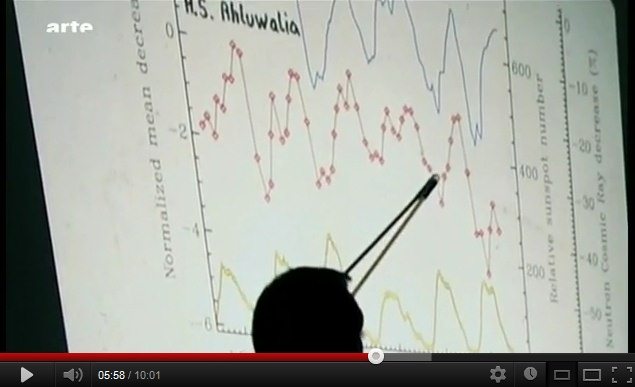
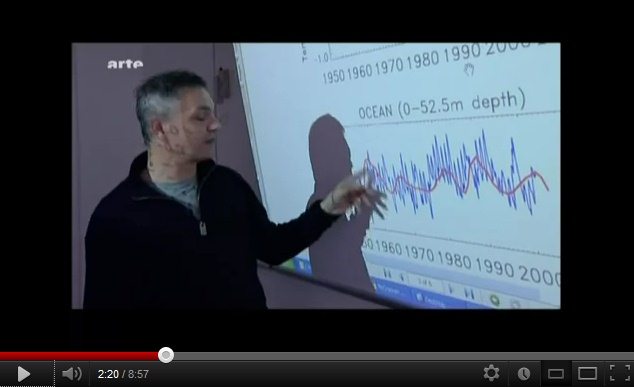
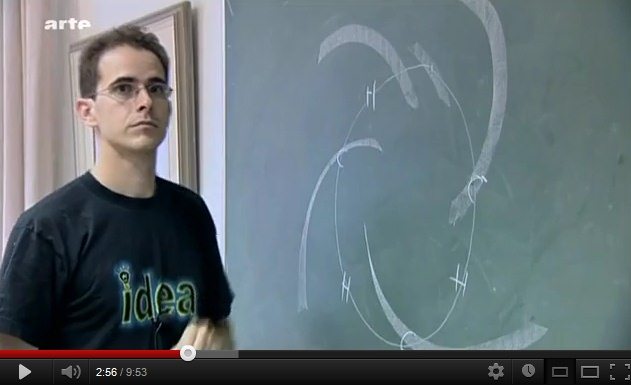
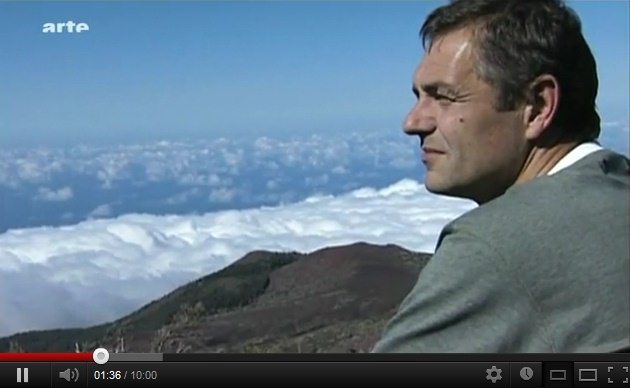
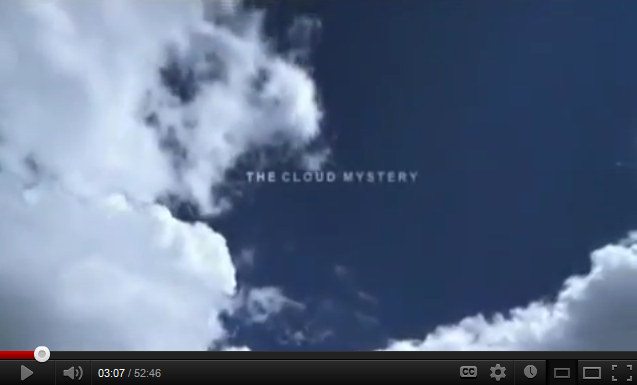
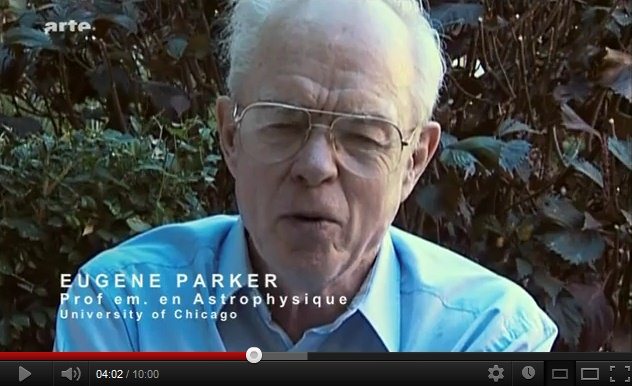
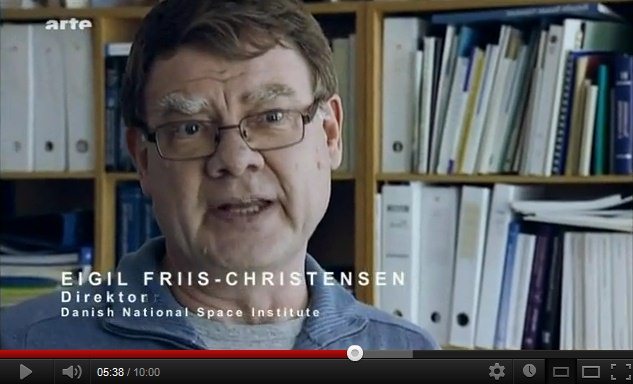
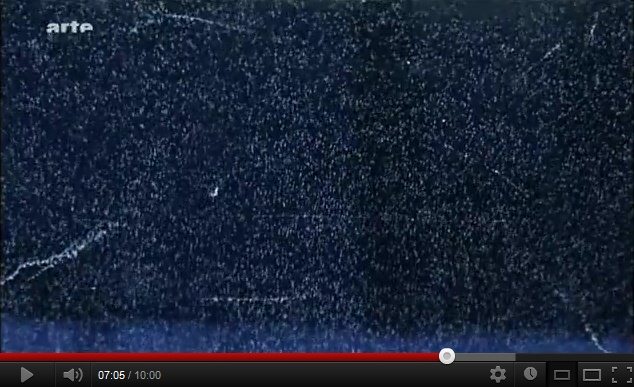
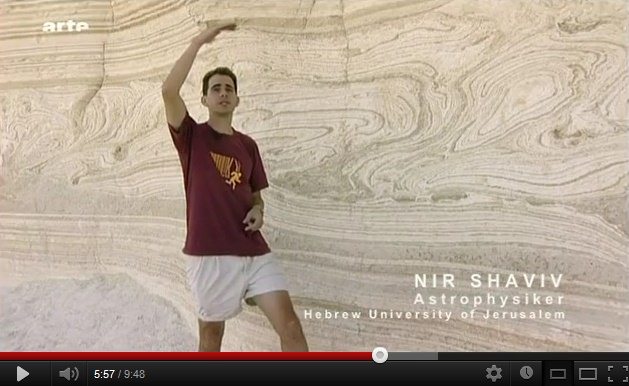
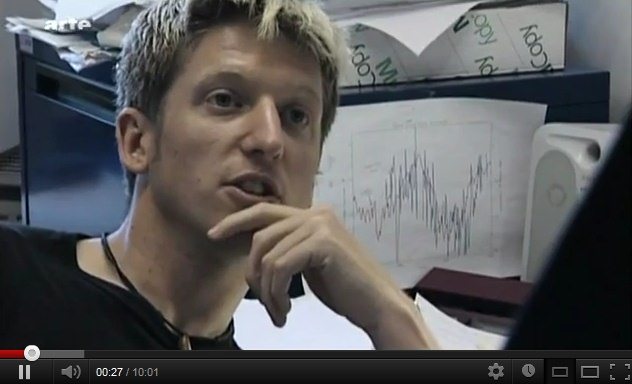
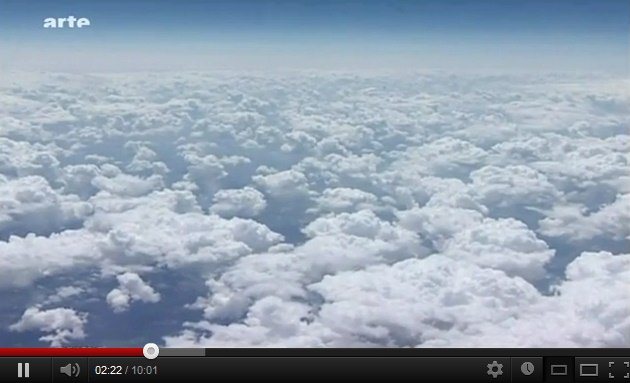
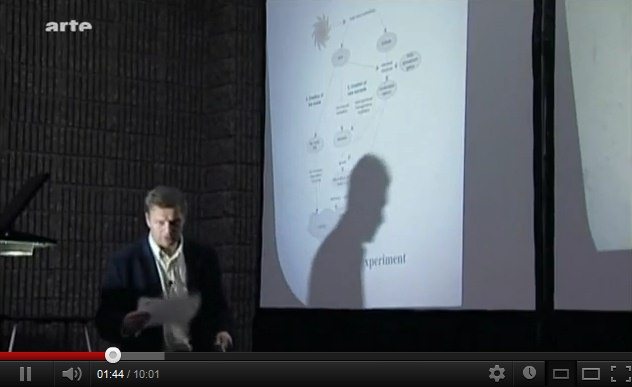
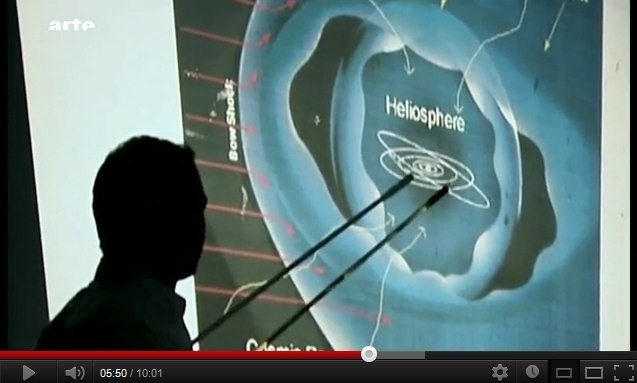
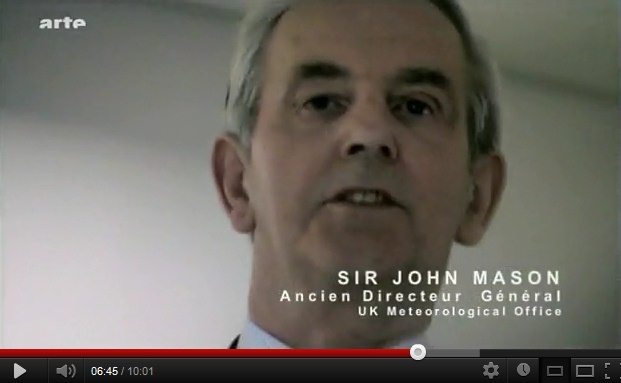
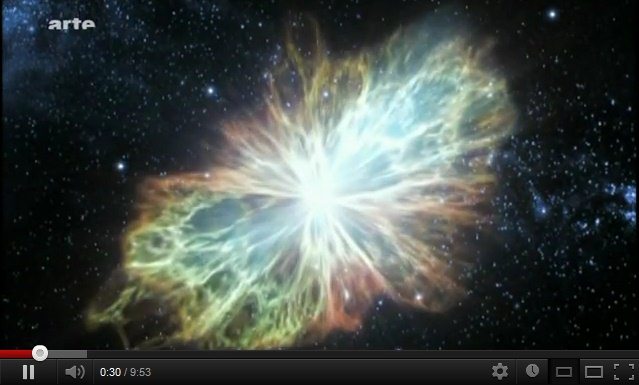
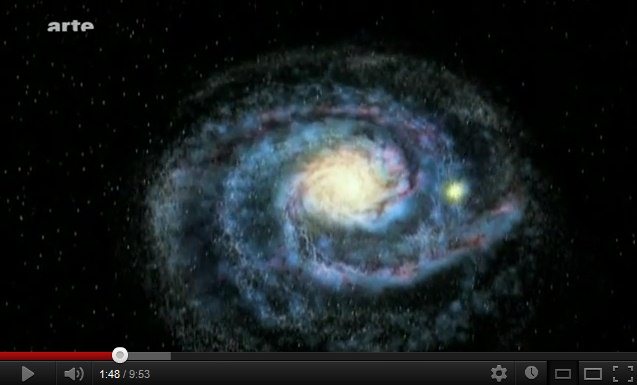
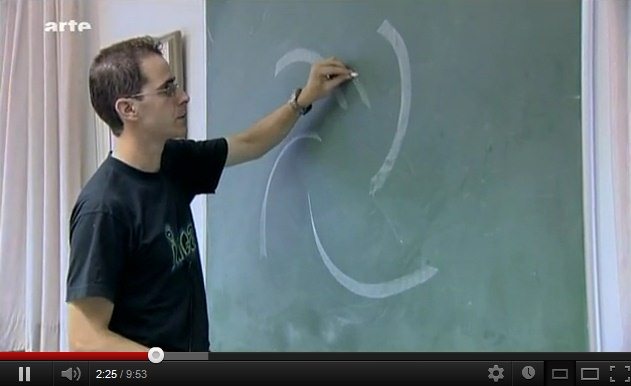
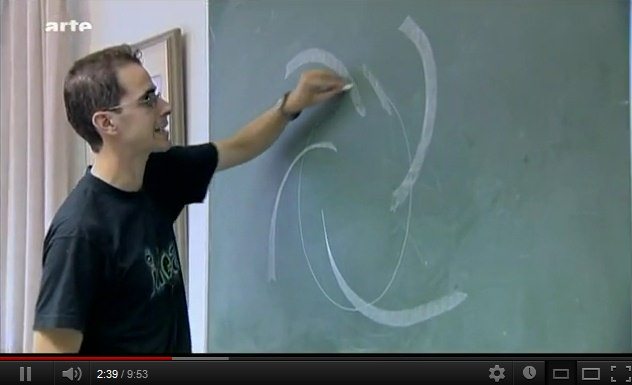
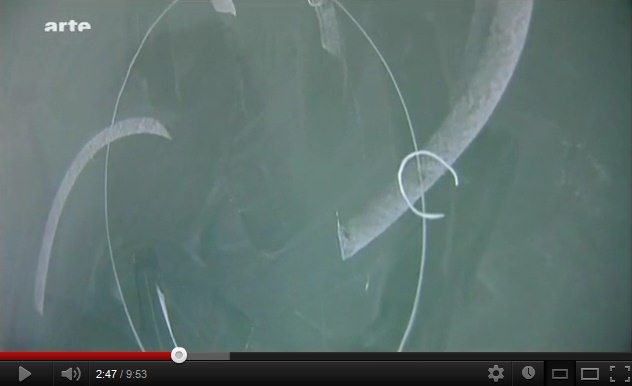
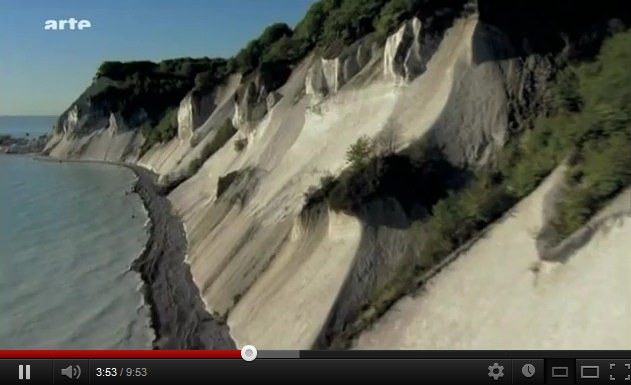
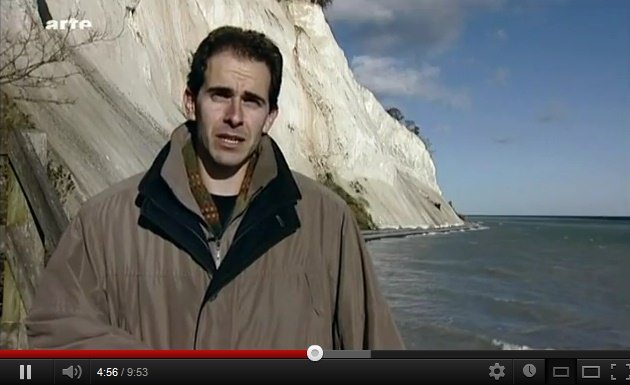
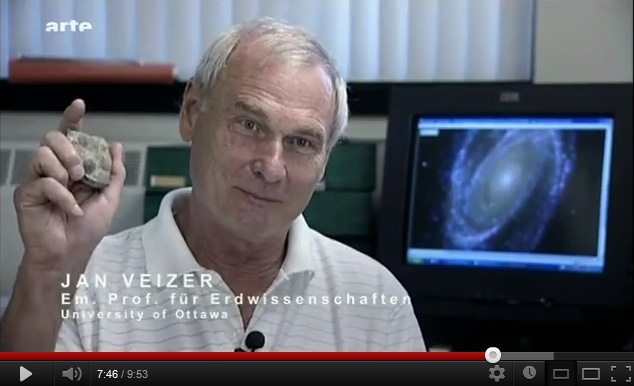
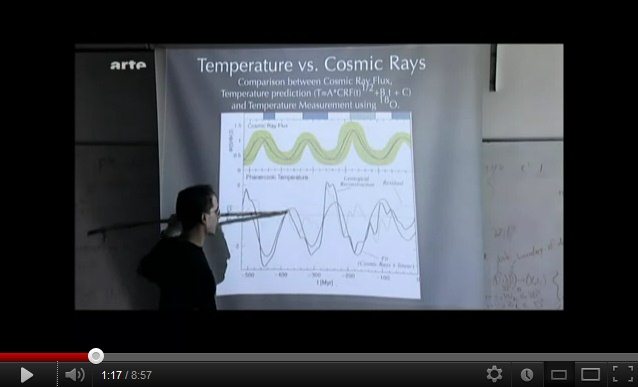
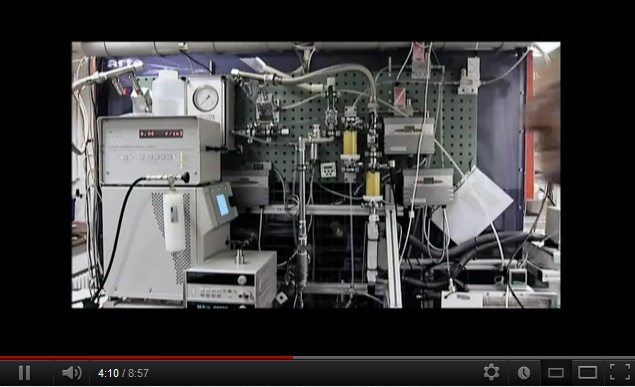
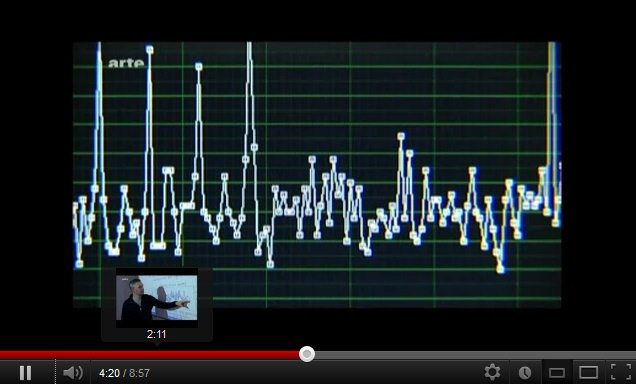
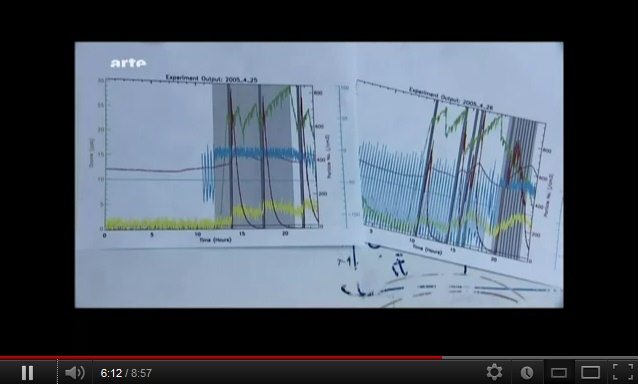
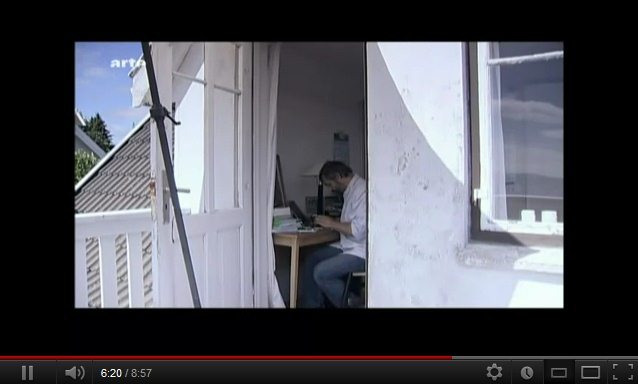

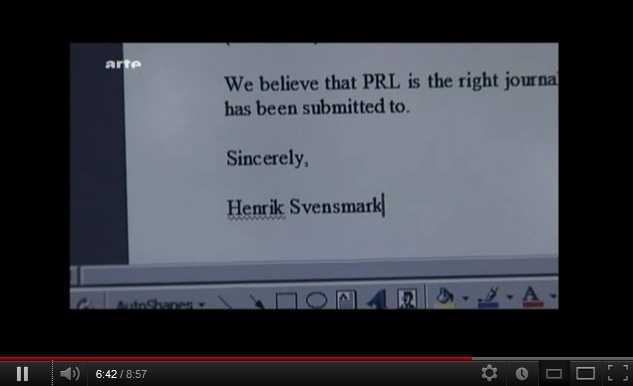
![Nir Shaviv with sunset
[probably at Jerusalem University] Nir Shaviv with sunset [probably at
Jerusalem University]](d/klimawandel-galaktisches-jahr-d/035-Nir-Shaviv-sonnenuntergang.jpg)
